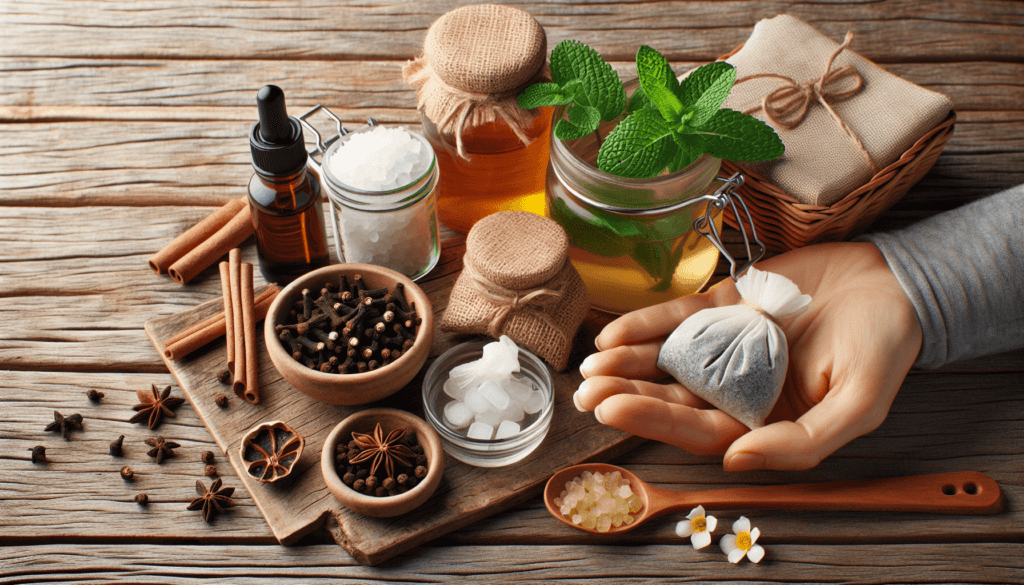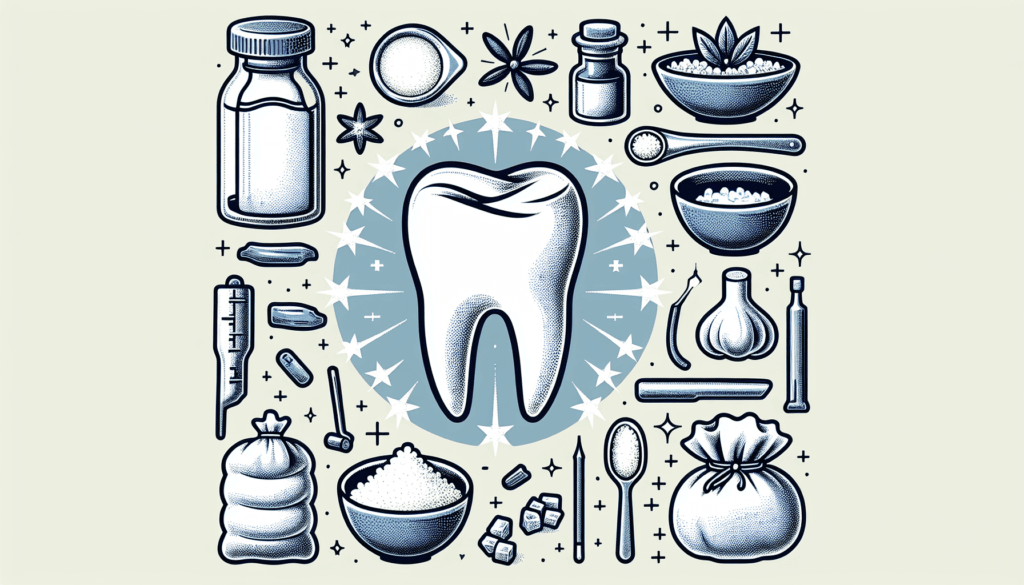Having a tooth extraction can be a painful experience, but there are several home remedies that can help alleviate the discomfort. In this article, you will discover effective ways to ease the pain after a tooth extraction using simple and natural ingredients that you probably have in your kitchen. These remedies are easy to prepare and can provide immediate relief, allowing you to recover faster and get back to your normal routine. Say goodbye to post-extraction pain with these home remedies that are sure to make you smile again.

Over-the-counter pain relievers
If you’re experiencing pain after a tooth extraction, one of the first things you can try is over-the-counter pain relievers. Nonsteroidal anti-inflammatory drugs (NSAIDs) and acetaminophen are commonly recommended for managing post-extraction pain.
Nonsteroidal anti-inflammatory drugs (NSAIDs)
NSAIDs, such as ibuprofen or naproxen, can help alleviate pain and reduce inflammation. These medications work by blocking the production of certain chemicals in the body that cause pain and swelling. It’s important to follow the instructions on the packaging and consult with your healthcare provider to determine the appropriate dosage for your specific needs.
Acetaminophen
Acetaminophen, commonly known as Tylenol, can also be effective in relieving pain after a tooth extraction. Unlike NSAIDs, acetaminophen does not possess anti-inflammatory properties. However, it can still provide pain relief by acting on the central nervous system. Again, it’s crucial to adhere to the recommended dosage and seek advice from your healthcare professional if needed.
Cold compress
Another remedy to consider is the use of a cold compress to numb the area and reduce swelling. Applying an ice pack or using frozen vegetables can help alleviate discomfort and promote healing.
Applying ice packs
To create an ice pack, you can wrap a few ice cubes in a thin towel or place them in a sealed plastic bag. Gently press the ice pack against the affected area for about 15 minutes at a time. Remember to take breaks in between to prevent potential damage to the skin.
Using frozen vegetables
If you don’t have an ice pack readily available, you can also use a bag of frozen vegetables as a substitute. Peas or corn are commonly used due to their small size and malleability. Make sure to wrap the bag in a cloth or towel to protect your skin and apply it to the extraction site in the same manner as an ice pack.
Saltwater rinse
A saltwater rinse can help keep the extraction site clean and reduce the risk of infection. This natural remedy can also provide relief by soothing any lingering pain or discomfort.
Preparing the saltwater solution
To create a saltwater rinse, dissolve half a teaspoon of salt in eight ounces of warm water. Stir the mixture until the salt is completely dissolved. Be sure to use lukewarm water rather than hot water to avoid causing any additional pain or irritation.
Gargling with the saline solution
Take a small sip of the saltwater solution and gently swish it around your mouth, making sure to focus on the extraction site. Continue to gargle the solution for a minute or two before spitting it out. Repeat this process several times a day, especially after meals, to keep the area clean and reduce discomfort.
Clove oil
Clove oil, derived from the clove plant, is renowned for its ability to ease toothache pain. It contains a compound called eugenol, which has natural analgesic and antibacterial properties.
Application of clove oil
To apply clove oil, dip a clean cotton ball or swab into the oil and gently blot it onto the extraction site. Alternatively, you can use a dropper to apply a few drops directly onto the affected area. Be cautious not to swallow the oil, as it can cause irritation or an upset stomach.
Precautions to take
While clove oil can provide temporary relief, it is crucial to use it sparingly and avoid excessive application. If you experience any adverse reactions, such as burning or increased pain, discontinue its use immediately. Additionally, consult with your dentist or healthcare professional before using clove oil, especially if you have any underlying health conditions or are taking medications.

Tea bags
Using tea bags as a home remedy for pain relief after a tooth extraction may seem unusual, but it can be surprisingly effective. Tea bags contain tannins, which possess astringent and anti-inflammatory properties.
Preparing the tea bag
Start by steeping a tea bag in hot water for a few minutes. Ensure that the tea bag is moist but not dripping with liquid. Once the tea bag is ready, allow it to cool down slightly to a comfortable temperature.
Placing the tea bag on the extraction site
Gently place the warm tea bag over the extraction site and hold it in place for about 15 minutes. The tannins in the tea can help alleviate pain and reduce inflammation. Additionally, the warmth from the tea bag can provide soothing relief and promote blood circulation to aid in the healing process.
Honey
Honey has been used for centuries as a natural remedy for various ailments, including toothaches. It possesses antibacterial, anti-inflammatory, and antioxidant properties, making it a potential option for pain relief after a tooth extraction.
Application of honey
Using a clean finger or a cotton swab, apply a small amount of honey directly to the extraction site. Gently massage the honey around the area for a few minutes to ensure proper coverage.
Benefits of using honey for pain relief
Honey not only helps alleviate pain but also provides a protective barrier against bacteria, reducing the risk of infection. Its anti-inflammatory properties can help reduce swelling and promote faster healing. Additionally, honey’s natural viscosity can create a soothing and comforting sensation in the mouth.
Aloe vera gel
Aloe vera is widely recognized for its soothing and healing properties. Applying aloe vera gel to the extraction site can help reduce pain and inflammation.
Applying aloe vera gel
Extract the gel from an aloe vera leaf or use a store-bought aloe vera gel. Apply a small amount of the gel directly onto the extraction site using a clean finger or a cotton swab. Gently massage the gel into the area for a couple of minutes to ensure absorption.
Soothing properties of aloe vera
Aloe vera contains various compounds that contribute to its soothing properties, including vitamins, minerals, and enzymes. It can help calm irritated tissues, promote the regeneration of damaged cells, and provide a cooling sensation that can alleviate discomfort.
Vanilla extract
Vanilla extract, commonly used in baking and cooking, can also serve as a natural analgesic for tooth extraction pain. Its mild numbing properties can help dull the sensation of pain and provide temporary relief.
Using vanilla extract as a natural analgesic
Dip a cotton ball or swab into a small amount of vanilla extract and gently dab it onto the extraction site. It’s important to note that while vanilla extract may help alleviate pain, it does not possess any antibacterial properties. Therefore, it should be used in conjunction with other oral hygiene practices to minimize the risk of infection.
Methods of application
In addition to directly applying vanilla extract to the extraction site, you can also mix it with a small amount of warm water to create a rinse. Swish the vanilla extract and water mixture around in your mouth for about 30 seconds before spitting it out. This method allows for broader coverage and can help provide temporary relief to larger areas of discomfort.
Turmeric paste
Turmeric, a vibrant yellow spice commonly used in cooking, contains a compound called curcumin that possesses powerful anti-inflammatory and analgesic properties. Applying a turmeric paste to the extraction site can help reduce pain and promote healing.
Preparing turmeric paste
Mix a teaspoon of turmeric powder with a small amount of water or coconut oil to create a thick paste. Ensure that the paste has a smooth consistency and is not too runny. You can adjust the ratio of turmeric to the liquid according to your preference.
Applying turmeric paste for pain relief
Using a clean finger or a cotton swab, apply a thin layer of the turmeric paste directly onto the extraction site. Gently massage the paste over the area to ensure even coverage. Leave the paste on for at least 10-15 minutes before rinsing it off with warm water.
Proper oral hygiene
Maintaining proper oral hygiene plays a crucial role in managing pain after a tooth extraction. Following these simple practices can help prevent infection and promote the healing process.
Brushing gently
Even though the extraction site may be tender, it is important to continue brushing your teeth. However, you should brush gently and avoid putting excessive pressure on the area. Use a soft-bristled toothbrush to minimize any potential discomfort.
Using a soft-bristled toothbrush
Switching to a soft-bristled toothbrush can be beneficial during the healing process. The soft bristles are more gentle on the gums and extraction site, reducing the chances of causing further irritation or pain.
Rinsing with mouthwash
In addition to brushing, rinsing with an antibacterial mouthwash can help eliminate bacteria and maintain oral hygiene. Opt for an alcohol-free mouthwash to avoid any stinging or burning sensation. Gently swish the mouthwash around your mouth, making sure to focus on the extraction site, and then spit it out. Repeat this process after meals or as directed by your dentist.
By utilizing these home remedies and practicing proper oral hygiene, you can effectively manage the pain and promote the healing process after a tooth extraction. However, it is important to remember that these remedies are intended for temporary relief and should not replace professional dental advice. If you experience prolonged or severe pain, persistent bleeding, or any other concerning symptoms, consult with your dentist for further evaluation and treatment.


